
Chechnya, officially the Chechen Republic, is a republic of Russia. It is situated in the North Caucasus of Eastern Europe, close to the Caspian Sea. The republic forms a part of the North Caucasian Federal District, and shares land borders with the country of Georgia to its south; with the Russian republics of Dagestan, Ingushetia, and North Ossetia-Alania to its east, north, and west; and with Stavropol Krai to its northwest.

The First Chechen War, also referred to as the First Russo-Chechen War, was a struggle for independence waged by the Chechen Republic of Ichkeria against the Russian Federation from December 1994 to August 1996. This conflict was preceded by the battle of Grozny in November 1994, during which Russia covertly sought to overthrow the new Chechen government. Following the intense Battle of Grozny in 1994–1995, which concluded as a pyrrhic victory for the Russian federal forces, their subsequent efforts to establish control over the remaining lowlands and mountainous regions of Chechnya were met with fierce resistance from Chechen guerrillas who often conducted surprise raids.

Akhmad-Khadzhi Abdulkhamidovich Kadyrov was a Russian politician and revolutionary who served as Chief Mufti of the Chechen Republic of Ichkeria in the 1990s during and after the First Chechen War. At the outbreak of the Second Chechen War he switched sides, offering his service to the Russian government, and later became the President of the Chechen Republic from 5 October 2003, acting as head of administration since July 2000.
The history of Chechnya may refer to the history of the Chechens, of their land Chechnya, or of the land of Ichkeria.
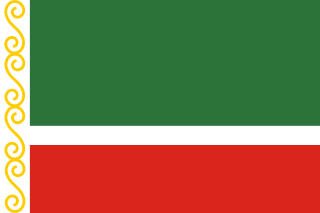
The flag of Chechnya is a rectangle with sides in the ratio 2:3 representing the Chechen Republic, a republic of Russia. The flag is composed of three horizontal bars of, from top to bottom: green, representing Islam; white; and red; superimposed on them is a narrow vertical white band at the hoist, containing the national ornament, a design of four golden scroll shapes.

The republics are one type of federal subject of the Russian Federation. 21 republics are internationally recognized as part of Russia; another is under its de facto control. The original republics were created as nation states for ethnic minorities. The indigenous ethnicity that gives its name to the republic is called the titular nationality. However, due to centuries of Russian migration, a titular nationality may not be a majority of its republic's population.
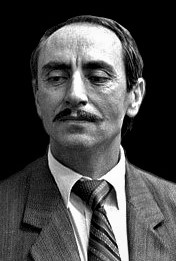
Dzhokhar Musayevich Dudayev was a Chechen politician, statesman and military leader of the 1990s Chechen Independence movement from Russia. He served as the first president of the Chechen Republic of Ichkeria, from 1991 until his assassination in 1996. Previously he had been a Major General of Aviation in the Soviet Armed Forces.

The president of Ichkeria, formally the president of the Chechen Republic of Ichkeria was the head of the Chechen Republic of Ichkeria from 1991 to 2007, the Islamic Republic that existed until the victory of the Russian Federation in the Second Chechen War.

The Checheno-Ingush Autonomous Soviet Socialist Republic, abbreviated as the Checheno-Ingush ASSR, was an autonomous republic within the Russian Soviet Federative Socialist Republic, in existence from 1936 to 1944 and again from 1957 to 1993. Its capital was Grozny. The 1979 census reported the territory had an area of 19,300 square kilometres (7,500 sq mi) and a population of 1,155,805 : 611,405 Chechens, 134,744 Ingush, and the rest were Russians and other ethnic groups.
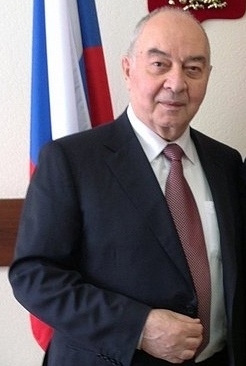
Doku Gapurovich Zavgayev is a Soviet and Russian diplomat and politician from Chechnya. He was the leader of the Checheno-Ingush ASSR.

The Chechen Republic of Ichkeria, known simply as Ichkeria, and also known as Chechnya, is a former de facto state that controlled most of the former Checheno-Ingush ASSR.

The Republic of Chechnya is a constituent republic and federal subject of the Russian Federation. It is located in the Caucasus region in southwest Russia. It is the political successor of the Checheno-Ingush Autonomous Soviet Socialist Republic. From a centralized form of government during the existence of the Soviet Union, the republic's political system went upheavals during the 1990s with the establishment of the Chechen Republic of Ichkeria, leading to the First Chechen War and the Second Chechen War which left the republic in total devastation. In 2000, following Russia's renewed rule, a local, republican form of government was established in the republic under the control of the Russian federal government.

The deportation of the Chechens and Ingush, or Ardakhar Genocide, and also known as Operation Lentil, was the Soviet forced transfer of the whole of the Vainakh populations of the North Caucasus to Central Asia on February 23, 1944, during World War II. The expulsion was ordered by NKVD chief Lavrentiy Beria after approval by Soviet leader Joseph Stalin, as a part of a Soviet forced settlement program and population transfer that affected several million members of ethnic minorities in the Soviet Union between the 1930s and the 1950s.

The Russian Soviet Federative Socialist Republic, previously known as the Russian Soviet Republic and the Russian Socialist Federative Soviet Republic, as well as being unofficially referred to as Soviet Russia, the Russian Federation, or simply Russia, was an independent federal socialist state from 1917 to 1922, and afterwards the largest and most populous Soviet socialist republic of the Soviet Union (USSR) from 1922 to 1991, until becoming a sovereign part of the Soviet Union with priority of Russian laws over Union-level legislation in 1990 and 1991, the last two years of the existence of the USSR. The Russian SFSR was composed of sixteen smaller constituent units of autonomous republics, five autonomous oblasts, ten autonomous okrugs, six krais and forty oblasts. Russians formed the largest ethnic group. The capital of the Russian SFSR and the USSR as a whole was Moscow and the other major urban centers included Leningrad, Stalingrad, Novosibirsk, Sverdlovsk, Gorky and Kuybyshev. It was the first socialist state in the world.

The Parliament of the Chechen Republic is the regional parliament of Chechnya, a federal subject of Russia. A total of 41 deputies are elected for five-year terms.

The Chechen–Russian conflict was the centuries-long conflict, often armed, between the Russian, Soviet and Imperial Russian governments and various Chechen forces. The recent phase of the conflict started after the dissolution of the Soviet Union in 1991 and lasted until 2017.
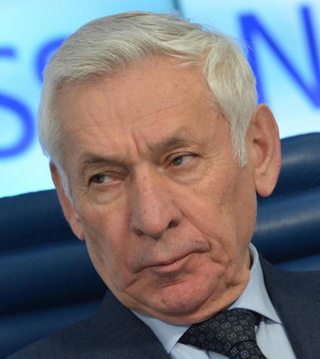
Salambek Naibovich Khadzhiyev was a Soviet-Russian Chechen petrochemist, businessman and politician who was the first Chairman of the Government of National Revival of the Chechen Republic. He specialized in the production of low-pour, high-density petroleum fuels transformations of hydrocarbons on zeolite that contain catalysts. He was also the first and only Chechen to hold a ministerial position in the Soviet Union. In 1991, he headed the Ministry of Chemical and Petrochemical Industry of the USSR. During the First Chechen War in 1995 he was the chairman of the Government of the National Revival of Chechnya.
The Decree of Sovereignty of the Chechen Republic was a formal declaration of independence for the autonomous Soviet Republic of Checheno-Ingush ASSR. Between 1991 and 2000 Chechnya was de facto an independent state. The declaration was issued on 1 November 1991, by the head of the All-National Congress of the Chechen People, Dzokhar Dudayev.
The Chechen Revolution was a series of anti-government protests in the Checheno-Ingush Autonomous Soviet Socialist Republic of Russian Soviet Federative Socialist Republic against the local Communist Party officials.
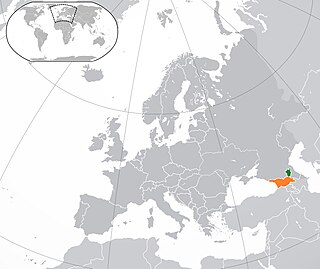
Relations between Georgia and the Chechen Republic of Ichkeria began in 1991, when both countries declared independence from the Soviet Union. They continued to pursue relations until Chechnya was re-annexed by Russia in 2000.

















